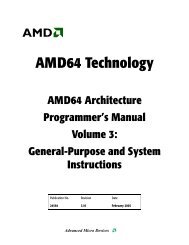Using TCP Through Sockets
Using TCP Through Sockets
Using TCP Through Sockets
Create successful ePaper yourself
Turn your PDF publications into a flip-book with our unique Google optimized e-Paper software.
they will operate). Following the bind operation, server and client paths diverge: instead of<br />
connecting the socket, a server will instead call listen followed by accept. These functions,<br />
described below, alert the operating system to accept new connects and, for each connection,<br />
create a new, connected socket which will be returned by accept.<br />
Section 3.6 shows the complete source code to a simple finger server. It listens for clients<br />
on the finger port, 79. Then, for each connection established, it reads a line of data, interprets<br />
it as the name of a user to finger, and runs the local finger utility directing its output back<br />
over the socket to the client.<br />
The function tcpserv takes a port number as an argument, binds a socket to that port,<br />
tells the kernel to listen for <strong>TCP</strong> connections on that socket, and returns the socket file<br />
descriptor number, or −1 on an error. This requires three main system calls:<br />
• int socket (int domain, int type, int protocol);<br />
This function creates a socket, as described in Section 3.2.<br />
• int bind (int s, struct sockaddr *addr, int addrlen);<br />
This function assigns an address to a socket, as described in Section 3.2. Unlike the<br />
finger client, which did not care about its local port number, here we specify a specific<br />
port number. INADDR ANY can still be specified as the local IP address: on a multihomed<br />
machine the socket will accept connections on any of the server’s addresses.<br />
Binding a specific port number can cause complications when killing and restarting<br />
servers (for instance during debugging). Closed <strong>TCP</strong> connections can sit for a while<br />
in a state called TIME WAIT before disappearing entirely. This can prevent a restarted<br />
<strong>TCP</strong> server from binding the same port number again, even if the old process no longer<br />
exists. The setsockopt system call shown in tcpserv avoids this problem. It tells the<br />
operating system to let the socket be bound to a port number already in use.<br />
• int listen (int s, int backlog);<br />
listen tells the operating system to accept network connections. It returns 0 on success,<br />
and −1 on error. s is an unconnected socket bound to the port on which to accept<br />
connections. backlog formerly specified the number of connections the operating system<br />
would accept ahead of the application. That argument is ignored by most modern<br />
Unix operating systems, however. People traditionally use the value 5.<br />
Once you have called listen on a socket, you cannot call connect, read, or write, as the<br />
socket has no remote end. Instead, a new system call, accept, creates a new socket for<br />
each client connecting to the port s is bound to.<br />
Once tcpserv has begun listening on a socket, main accepts connections from clients, with<br />
the system call accept.<br />
• int accept (int s, struct sockaddr *addr, int *addrlenp);<br />
9
















